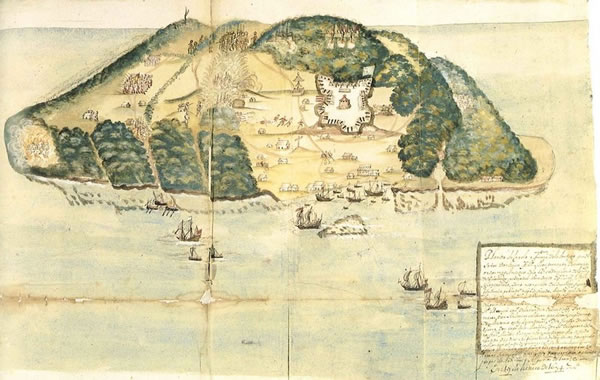Tortuga or Turtle Island, presently known as Ile de la Tortue and located off the Northwest shore of present day Haiti, on the Island of Hispaniola. Not to be confused with Isle Tortuga, a modern day island owned by Venezuela or the Dry Tortuga's owned by the United States. Tortuga is approximately 20 miles long and no more than 4 miles wide.
Tortuga was first discovered and named by the Spanish. The name Tortuga means Sea Turtle. It was anmed this because the island reesembles a large turtle. Despite its immediate proximity to Hispanola, an island claimed by Spain sine the time of Columbus, the French decided to establish a settlement of sorts on the island in 1625. Most of the settlers came from the nearby French colonies of St. Kitts and Nevis.
To make matters worse, the Spaniards built a fort on Tortuga after they chased away the French. Realizing they had only chased them over to Hispanola, the Spaniards left the fort with a small garrison to protect it and headed off in pursuit of the Buccaneers. This was a bad idea. The lightly held fort was easily taken by the Buccaneers in a counter attack, and the French set about improving the fortifications. The island would remain a French colony from then on, despite repeated attacks by the Spaniards.
Strategically, Tortuga was a most important island for France. To the Northeast of Tortuga, is Cuba, the last stop of the Treasure Fleet before returning to Spain. France, like most of Europe was at war with Spain for most of the 1600s. Tortuga became a perfect spot to ambush the returning Spanish fleets.
The French Governors of Tortuga would, for a price, offer safe harbor to just about any ship that wasn't Spanish. They were also entrusted with the powers to offer letter of Marques to privateers and weren't too picky on the nationality of the crew so long as they agreed to attack Spanish ships and split the booty with them. As such Tortuga became the home of the Brethren of the Coast.

Tortuga Island
At around this same time, Anthony Hilton, and Englishman, sets up an English Colony on the island. The English and the French on Tortuga at first were allies against the greater enemy, Spain. This however was short lived as the two start fighting over the imported slaves on the island] and who had rights to what property. When the Spaniards got word of this they decided to attack Tortuga and wipe out thedivided intruders. They managed to wipe out the English colony but the French and the English survivors once again fled the island.
It seems like Tortuga really had nothing for the Spaaniards because once again as soon as the interlopers were gone, the Spaniards left. And once again as the Spaniards left and like roaches the Buccaneers returned.
By now the buccaneers are attempting to raise sugar cane and tobacco. While not raising crops they are attacking the Spanish Fleets. By 1641, the French colony has become so well established that the French send Jean Le Vasseur to take control of the island. Le Vasseur managedto expel the English Colony, so to speak. The English Plantation became French in name but most of the population of Tortuga is made of pirates and privateers and these remain on the island with the blessing of the French Government. The pirate fleets offer both protection and income to the small colony. Most of the pirates/privateers are English or French. In order to keep the pirates happy and around, the French governor imported hundred of prostitutes.
By this time, the pirate/privateer community is firmly established on Tortuga and enjoys the support of the French Government. Pirates of any nationality are free to roam the seas around Tortuga under loosely written Letters of Reprisal against the Spanish government. Eventually this is frowned upon and the French make efforts to weed their privateer ranks of Dutch Freebooters and English privateers. The man primarily responsible for this action is Governor Monsieur D'Ogeron. The English in turn head for Jamaica and safe harbor while the Dutch head off to Virgin Islands, primarily St. Thomas.
Among the notable pirates to have ventured into Tortuga is none other than Henry Morgan who arrived there in 1660 as and indentured servant. He soon deserted a cruel boss and joined the ranks of Buccaneers, later moving his base of operation to Jamaica.
Among the French pirates was none other than Jean David L'Ollonais , probably one of the cruelest men to ever hold a cutlass in his hand.
In 1670 Henry Morgan accepted French Letters of Commission and he actively promoted the island of Tortuga as a base of operations and for the disposal of booty. In that year, 500 buccaneers from Tortuga and a 1000 buccaneers from Jamaica, under the command of Henry Morgan set out to pillage and plunder "legally" with a Letter of Marque. They attacked Santa Marta, Rio de la Hacha, Puerto Bello and Panama. Morgan received a formal vote of thanks from the Council of Jamaica in May of 1671 for his activities.
By the 1680s, laws were made that English seaman sailing under foreign flags were traitors to the Throne and pirates. Several Englishmen sailing from Tortuga under French letters of marque were convicted and hanged for piracy after attacking Dutch ships. When the Spanish gold began to dwindle the buccaneers turned their attention to Jamaican plantations and English Merchant ships. This led to protests from the English government to the King of France. Eventually the buccaneers were privateers only in name and attacked anything that wasn't French. The Governor-general of the French Colonies attempted to bring the buccaneers under control but failed.
Finally, in 1684 the Treaty of Ratisbone was signed which formally ended hostility between France and Spain. With the treaty came the withdrawal of all Letters of Marques. From that point on, the Buccaneers who continued attacks were pirates and were quickly hanged. Many of the former privateers were employed by the government of France to hunt down their former Brethren of the Coast.
While piracy would continue in and around Tortuga for years to come, it no longer enjoyed the status as a Home of the Buccaneers. The pirates found that it was better in the Bahamas, so to speak.

The only author and editor of all pages on the site. Most of what I write about is based on years of book reading on the topic. My first web page was published back in 1994.